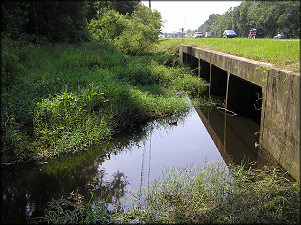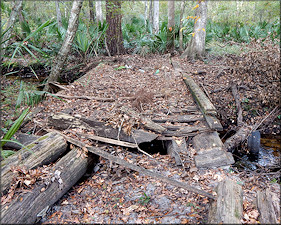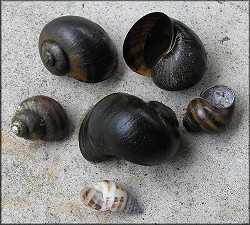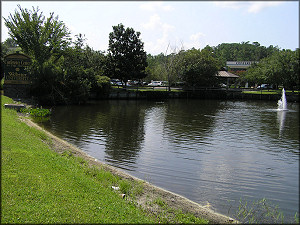|
Freedom Commerce Center Tract, Southeastern Duval County, Florida |
|
|
On April 17, 2003 recognized aquatic and terrestrial mollusk experts
Harry G. Lee and Henry McCullagh conducted a survey of the molluscan
fauna of what has come to be known as the Freedom Commerce Center Tract
[located north of the Avenues Mall and east of Philips Highway (Route
US-1)] as a prelude to a proposed controversial commercial development
of the area. Among the species identified during this survey were
a population of Pomacea paludosa in a small shallow creek on the
property. On August 23, 2005, this scribe made a follow-up visit to the area which is located in the 9500 block of Philips Highway. Upon arrival at the creek (upper reaches of Julington Creek) where it intersects Philips Highway, Pomacea paludosa egg clutches were evident on both low vegetation and the concrete box culvert which runs under the highway. Three live specimens were soon found feeding on the ample vegetation. A visit was then made to a small lake/retention pond in a commercial plaza in the same general area at the intersection of Gazebo Park Place South and Philips Highway; but to the west of the highway. The shoreline was littered with dead Pomacea paludosa but no live specimens or egg clutches were found to indicate their continued presence. It appeared likely that the lake may have been treated with a herbicide which exterminated the aquatic mollusk population of which four species were seen. A more extensive investigation of the same general area was made two days later. Not only were Pomacea paludosa found upstream and downstream in the shallow creek, but also in another nearby small retention pond and a very shallow roadside ditch (two inches deep). In the case of the latter, it's amazing that the species is able to survive at all in such marginal habitat, but in addition, also apparently survive the freezing winter weather and maintain a breeding population. Egg clutches were observed on the shallow ditch periphery. The profusion of egg clusters at the retention pond [see image] indicates a very large Pomacea population is present there despite the ponds small size. Based upon the above observations, it appears likely that many of the other impoundments/waterways in this somewhat rural and mostly undeveloped area of Duval County contain breeding populations of Pomacea. |
|
|
[Click on the images below for a higher resolution version.] |
|
|
Culvert Running Under Phillips Highway |
Old Wooden Bridge Over The Creek Upstream |
|
Freedom Commerce Center Pomacea paludosa |
Commercial Plaza Lake/Retention Pond |
|
Freedom Commerce Center Tract Species List |
|
Updated on 11/27/2016 |
|
Aquatic Species (14) |
|
|
Terrestrial Species (35) |
|
Land snails collected from drift taken on
wooden
bridge over small creek, low Palmetto woods, 40 m. E. U.
S. 1, 0.8 km N. jct. I-95, (S. E.) Jacksonville, Duval Co., Florida
[Freedom Commerce Center tract]
by Bill Frank on 8/31/2005 - GPS
= 30.11330N 081.33687W. Phylogenetic
order; two highlighted taxa new to the Northeast Florida Checklist;
included are three additional species [indented] found in the same
area but
not in drift sample: Helicina (Olygyra) orbiculata (Say, 1818) Carychium mexicanum Pilsbry, 1891 Southern Thorn Columella simplex (Gould, 1841) Toothless Column * Gastrocopta contracta (Say, 1822) Bottleneck Snaggletooth Gastrocopta corticaria (Say, 1817) Bark Snaggletooth ** Gastrocopta pellucida (Pfeiffer, 1841) Slim Snaggletooth Gastrocopta pentodon (Say, 1822) Comb Snaggletooth Gastrocopta rupicola (Say, 1821) Tapered Snaggletooth Gastrocopta tappaniana (C.B. Adams, 1841) White Snaggletooth Pupisoma dioscoricola (C.B. Adams, 1845) Yam Babybody Pupisoma mcneilli (Clapp, 1918) Gulf Babybody Vertigo milium (Gould, 1840) Blade Vertigo Vertigo oralis Sterki, 1898 Palmetto Vertigo Vertigo ovata Say, 1822 Ovate Vertigo Strobilops aeneus Pilsbry, 1926 Bronze Pinecone Strobilops hubbardi (A.D. Brown, 1861) Flattened Pinecone Strobilops texasianus Pilsbry and Ferriss, 1906 Southern Pinecone Helicodiscus notius notius Hubricht, 1962 Tight Coil Lucilla cf. singleyana (Pilsbry, 1889) cf. Smooth Coil Punctum minutissimum (Lea, 1841) Small Spot Glyphyalinia umbilicata (Singley in Cockerell, 1893) Texas Glyph Hawaiia alachuana (Dall, 1885) Southeast Gem Hawaiia minuscula (A. Binney, 1841) Minute Gem Mesomphix globosus (MacMillan, 1940) Globose Button 11/27/16 Striatura meridionalis (Pilsbry and Ferriss, 1906) Southern Striate Ventridens cerinoideus (Anthony, 1865) Wax Dome Zonitoides arboreus (Say, 1817) Quick Gloss Euconulus trochulus (Reinhart, 1883) Silk Hive Guppya gundlachii (Pfeiffer, 1840) Glossy Granule Drymaeus dormani (Binney, 1852) Manatee Treesnail Lobosculum pustula (Férussac, 1832) Grooved Liptooth Polygyra cereolus (Mühlfeld, 1816) Southern Flatcoil Lamellaxis micrus (d'Orbigny, 1835) Tiny Awlsnail Non-native Species * One well-preserved adult shell only. This is a predominantly northern species which reaches the southern Appalachians at higher altitudes. However, Hubricht (1985) records C. simplex from Conecuh Co., AL, and Chicago's Field Museum of Natural History (FMNH), which inherited the Hubricht Collection, has 12 specimens of Columella sp. (FMNH 235387; Hubricht! 1959) from Efaula, Barbour Co., AL. The Field also has 17 specimens thus labelled (FMNH 235388; Hubricht! 1959) from five miles W. of McBean, Richmond Co., GA. These AL records are from the Gulf Coastal Plain, and the GA lot is from the Atlantic Coastal Plain. Furthermore, Hubricht collected C. simplex from 11 localities (FMNH database) and five counties Hubricht (1985) in MS, all of which state lies in the Gulf Coastal Plain. Other records from the southeast U. S. include C. simplex from Chambers Co., AL (Piedmont) as well as White and Towns Cos. GA (Montane). Hubricht (1985) stated that C. simplex, somewhat belying its specific epithet, "is at least two species, probably three," so it is likely he considered the shells (he) labelled as "Columella sp." at the Field Museum to be different from the many he had labelled C. simplex from more northern localities. However, I can find no difference between this specimen and material collected in MA, VT, and ME. ** One well-preserved adult shell only. Although widespread in the eastern U. S., G. corticaria is very rare in Florida. Hubricht (1985) records it from Alachua and Marion Cos. The Florida Museum of Natural History (FLMNH) has a Columbia Co., FL record (UF 261838). FLMNH Malacology database <http://www.flmnh.ufl.edu/scripts/dbs/malacol_pub.asp>. FMNH Malacology database <http://fm1.fieldmuseum.org/collections/search.cgi?dest=inverts&action=form>. Hubricht, L., 1985, The distributions of the native land mollusks of the Eastern United States. Fieldiana 24(1359): pp. 1-191 + viii. |



